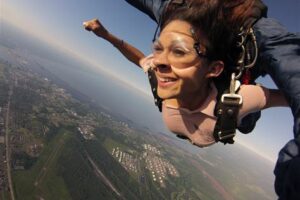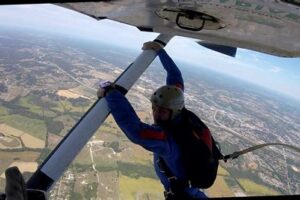Table of Contents
Discover the thrill and danger of skydiving. This exhilarating adventure sport is not for the faint-hearted. Explore the risks involved, from potential equipment malfunctions to parachute failures. Learn how proper training and safety measures can mitigate these dangers, allowing you to experience the ultimate adrenaline rush in a controlled environment. Dive into the world of skydiving and embrace the excitement while understanding the importance of caution.
Skydiving is an exhilarating and adrenaline-pumping adventure that captivates the hearts of thrill-seekers worldwide. However, amidst the breathtaking views and the rush of freefall, one cannot ignore the inherent dangers associated with this extreme sport. With every jump, skydivers face a myriad of potential risks that demand utmost caution and proper preparation. From equipment malfunctions to unpredictable weather conditions, the sky is not always the limit when it comes to skydiving. In this article, we will explore just how dangerous this adrenaline-fueled activity can be and shed light on the measures that must be taken to ensure safety in the skies.
The Thrill and Danger of Skydiving
Skydiving is a thrilling and exhilarating sport that has gained popularity over the years. It is an activity that involves jumping out of an aircraft, freefalling through the sky, and then safely landing with the help of a parachute. While skydiving can provide an incredible adrenaline rush and a unique perspective of the world, it is important to acknowledge the potential dangers associated with this extreme sport.
Stringent Safety Measures
Despite its inherent risks, skydiving is heavily regulated and safety measures are taken very seriously within the industry. Professional skydivers undergo rigorous training and must adhere to strict protocols to minimize the chances of accidents. Equipment inspections, proper maintenance, and regular upgrades are crucial to ensure the safety of both the skydiver and the equipment. Additionally, skydiving centers have safety procedures in place, including detailed pre-flight briefings, tandem jumping for beginners, and experienced instructors accompanying novices during their jumps.
Potential Risks and Accidents
While safety precautions are implemented, skydiving still carries inherent risks. Accidents can occur due to various factors such as equipment malfunction, human error, adverse weather conditions, or unforeseen circumstances during the jump. Parachute malfunctions, collisions with other skydivers or objects, and landing injuries are some of the potential risks that skydivers face. However, it is important to note that the occurrence of accidents is relatively rare compared to the number of jumps made every year.
The Importance of Training and Experience
Proper training and experience play a vital role in minimizing the dangers associated with skydiving. Novice skydivers are often required to complete a series of training jumps before they can progress to more advanced techniques. This training covers essential skills such as body positioning, parachute deployment, emergency procedures, and landing techniques. Experienced instructors provide guidance and mentorship to ensure that skydivers are equipped with the necessary knowledge and skills to handle various situations that may arise during a jump.
Physical Fitness and Health Requirements
Skydiving demands a certain level of physical fitness and health. Jumpers must meet specific requirements to ensure they are physically capable of handling the intense experience. Individuals with heart conditions, high blood pressure, or other medical issues may be advised against participating in skydiving. It is crucial to disclose any health concerns to the instructors and undergo any necessary medical examinations before attempting a jump.
Psychological Preparedness
Skydiving also requires psychological preparedness. The sport can be mentally challenging, particularly for those who have a fear of heights or are prone to anxiety. It is crucial for individuals to assess their mental state and determine if they are ready to face the potential dangers and uncertainties that come with skydiving. Mental fortitude, focus, and the ability to make split-second decisions are essential qualities for a skydiver.
The Adrenaline Rush and Addiction
One reason skydiving is so popular despite its risks is the adrenaline rush it provides. The intense thrill of freefalling and the breathtaking views during descent create an unmatched experience. This rush of adrenaline can be addictive, leading many people to pursue skydiving as a regular hobby or even a profession. However, it is important for individuals to maintain a balance and not let the addiction compromise their safety by taking unnecessary risks or neglecting proper training and equipment checks.
Effective Risk Management
Despite the risks involved, skydiving can be relatively safe when proper risk management strategies are implemented. Skydiving centers and instructors continuously evaluate and update their safety protocols to minimize the chances of accidents. Assessing weather conditions, providing thorough briefings, maintaining well-maintained equipment, and adhering to strict regulations are all part of effective risk management in skydiving. It is essential for both beginners and experienced jumpers to prioritize safety and follow established guidelines.
The Importance of Personal Responsibility
Ultimately, the responsibility for personal safety lies with the individual skydiver. It is crucial to be aware of one’s limitations, follow proper procedures, and make informed decisions before attempting a jump. Ignoring safety measures, cutting corners, or taking unnecessary risks can significantly increase the dangers associated with skydiving. Personal responsibility, combined with proper training and adherence to safety protocols, is key to ensuring a safe and enjoyable skydiving experience.
Weighing the Risks and Rewards
Skydiving undoubtedly carries risks, but for many thrill-seekers, the rewards far outweigh them. The breathtaking views, adrenaline rush, and sense of accomplishment make skydiving an unforgettable experience. By understanding and respecting the dangers involved, undergoing proper training, and maintaining personal responsibility, individuals can enjoy the thrills of skydiving while minimizing potential risks. It is essential to approach this extreme sport with caution and respect, thereby ensuring a safe and exhilarating adventure in the skies.
Introduction:
Skydiving has long been considered an extreme sport that entices thrill-seekers from all walks of life. As with any adrenaline-pumping activity, questions arise about the potential dangers associated with skydiving. This article will explore various aspects of skydiving, shedding light on the risks involved and the measures in place to minimize them.
1. Skydiving Accident Statistics:
Skydiving accidents, though rare, do occur. According to the United States Parachute Association (USPA), the overall fatality rate in 2019 was only 0.0065%, with the majority of deaths being attributed to human error rather than equipment failure. It is important to note that these accident rates are significantly lower than many other widely accepted activities, such as driving a car.
2. Training and Certification:
To mitigate the risks and ensure the safety of participants, rigorous training programs and certifications are required in most countries. These programs cover everything from parachute handling and landing techniques to emergency procedures. Skydiving centers adhere to strict guidelines and regulations set by the governing bodies to maintain safety standards.
3. Equipment Reliability:
Modern skydiving equipment undergoes extensive testing and adheres to stringent manufacturing standards. Parachutes are designed with multiple fail-safe mechanisms, such as automatic activation devices and reserve parachutes. Routine inspections and maintenance protocols are followed to ensure equipment safety, reducing the likelihood of equipment failure.
4. Weather Conditions:
Weather plays a crucial role in skydiving safety. Skydiving operations are weather-dependent, and experienced instructors and organizers constantly monitor conditions to decide whether it is safe to jump. Excessive wind speeds, thunderstorms, or poor visibility can lead to canceled jumps, emphasizing the importance of prioritizing safety over thrill.
5. Instructor Expertise:
Skydiving centers employ trained and experienced instructors who undergo extensive training themselves. These experts are well-versed in safety protocols, emergency procedures, and improvisation techniques if unexpected situations arise during a jump. Their expertise ensures that participants receive proper guidance and supervision, minimizing the risks associated with the activity.
6. Risk Management:
Skydiving centers focus on risk management to maintain a safe environment for participants. This involves meticulous planning, thorough safety briefings, and adherence to strict protocols. Constant assessment of potential hazards, continuous training of staff, and strict compliance with guidelines contribute to a comprehensive risk management approach.
7. Physiological Considerations:
While skydiving poses certain risks, many of them can be mitigated through careful consideration of an individual’s health and physical condition. Prior to participating in a jump, individuals are often required to disclose any pre-existing medical conditions and may be subject to a medical examination. This process helps identify potential contraindications and ensure that individuals are fit to undertake the activity.
8. Personal Responsibility:
Like any adventure sport, personal responsibility is essential when it comes to skydiving. Following safety guidelines, participating in proper training, and making informed decisions about the weather conditions are crucial steps in minimizing risks. By understanding the importance of personal responsibility and adhering to safety protocols, participants can further enhance their own safety during skydiving adventures.
Conclusion:
While skydiving carries inherent risks, when proper safety measures are followed, it remains a relatively safe activity. With comprehensive training, certified instructors, reliable equipment, thorough risk management, and awareness of personal responsibility, the chances of accidents or injuries can be significantly reduced. Ultimately, it is important for individuals to make informed decisions and prioritize safety as they embark on this exhilarating experience.
As a professional in the field of extreme sports and adventure activities, I am often asked about the dangers associated with skydiving. It is important to approach this topic with a balanced perspective, considering both the risks involved and the safety measures put in place to mitigate them. Here, I will outline a professional point of view on the potential dangers of skydiving.
- Risk of equipment malfunction: Skydiving involves the use of specialized equipment, including parachutes, harnesses, and altimeters. While modern gear is designed to be highly reliable, there is always a small chance of equipment malfunction. However, it is crucial to emphasize that strict maintenance protocols, regular inspections, and rigorous training contribute significantly to minimizing such risks.
- Weather conditions: Weather plays a significant role in skydiving safety. High winds, storms, or other adverse weather conditions can affect the stability of the jump and increase the chances of accidents. Professional skydiving centers closely monitor weather patterns and make informed decisions about when it is safe to jump. They prioritize the well-being of participants and will not allow jumps if conditions are deemed unsafe.
- Human error: Mistakes made by skydivers themselves can lead to dangerous situations. Incorrect body positioning during freefall, failure to deploy the parachute at the correct altitude, or errors in canopy control can all pose risks. However, comprehensive training programs, mandatory certification requirements, and experienced instructors help minimize the likelihood of human error. Skydiving centers prioritize thorough education and ongoing training to ensure participants are well-prepared and capable of making safe decisions while in the air.
- Physical strain: Skydiving can exert physical strain on the body, particularly during the landing phase. The impact of landing can put stress on joints and muscles, potentially leading to injuries if not executed correctly. However, proper landing techniques, adequate physical fitness, and the guidance of experienced instructors significantly reduce the risk of injury. It is important for participants to follow instructions carefully and maintain good overall physical health.
- Emergency situations: While rare, emergency situations such as parachute malfunctions or collisions during freefall can occur. Skydiving centers are well-prepared to handle these scenarios. Instructors are trained in emergency procedures and carry reserve parachutes, ensuring that they can respond quickly and effectively to any unforeseen events. Regular emergency drills and safety protocols are in place to minimize any potential harm.
In conclusion, while skydiving does involve inherent risks, the sport has come a long way in terms of safety standards and practices. With stringent equipment checks, thorough training programs, continuous education, and the presence of experienced instructors, the dangers associated with skydiving are significantly mitigated. Skydiving can be a thrilling and rewarding experience when carried out in a professional and responsible manner.
Thank you for taking the time to visit our blog and explore the thrilling world of skydiving with us. As you have read throughout this article, skydiving is undoubtedly an adrenaline-pumping adventure that offers a unique experience like no other. However, it is crucial to acknowledge the inherent risks involved in this extreme sport.
Firstly, it is important to understand that skydiving comes with inherent dangers that cannot be completely eliminated. Despite rigorous safety measures and training, accidents can still occur. The act of jumping out of an aircraft at thousands of feet above the ground will always carry a certain level of risk. It is essential to recognize this fact before deciding to embark on a skydiving journey.
Secondly, it is vital to choose a reputable skydiving facility with experienced instructors and well-maintained equipment. Proper training and adherence to safety protocols can significantly reduce the risks associated with skydiving. Researching and selecting a certified skydiving center will not only enhance your safety but also ensure a more enjoyable experience overall.
In conclusion, while skydiving undeniably poses risks, it is a thrilling and exhilarating sport that can provide a once-in-a-lifetime adventure. It is essential to approach skydiving with caution and a respect for the inherent dangers involved. By choosing a reputable skydiving center and following all safety guidelines, you can mitigate some of these risks and increase the likelihood of a safe and memorable experience. Ultimately, if you are willing to embrace the thrill and accept the risks, skydiving can offer an unforgettable and life-changing experience.
Thank you again for joining us on this journey through the world of skydiving. We hope that this article has provided you with valuable insights into the dangers associated with this extreme sport. Remember, always prioritize your safety and make informed decisions when considering any adventure activity. Stay safe and keep exploring!
.
People Also Ask: How Dangerous Is Skydiving?
1. Is skydiving really dangerous?
Skydiving does come with inherent risks, as it involves jumping out of an aircraft and freefalling at high speeds before deploying a parachute. However, when safety guidelines and protocols are followed, the risk of injury or fatality is significantly reduced. Skydiving centers prioritize safety by employing experienced instructors, maintaining equipment regularly, and adhering to strict regulations.
2. What are the main dangers of skydiving?
The main dangers of skydiving include parachute malfunctions, collisions with other skydivers or objects in the air, and landing accidents. Parachute malfunctions can range from minor issues that can be addressed in mid-air to more serious situations that may require emergency procedures. Collisions can occur during formation jumps or if skydivers fail to maintain proper spacing. Landing accidents can happen if the landing is not executed properly or if unfavorable weather conditions exist.
3. How common are skydiving accidents?
While skydiving accidents do occur, they are relatively rare. According to the United States Parachute Association, there were 15 fatal skydiving accidents out of approximately 3.3 million jumps in 2020, resulting in a fatality rate of 0.0045%. This demonstrates that skydiving, when conducted under proper supervision and adherence to safety protocols, can be a reasonably safe activity.
4. Can you die from skydiving?
While skydiving carries inherent risks, the fatality rate is relatively low. According to statistics, the chance of dying in a skydiving accident is approximately 1 in 100,000 jumps. This means that the vast majority of skydivers complete their jumps safely. By choosing a reputable skydiving center, undergoing proper training, and following safety procedures, the risk of a fatal incident can be minimized.
5. How can I increase my safety while skydiving?
To enhance your safety while skydiving, it’s important to:
- Choose a well-established and reputable skydiving center that prioritizes safety.
- Ensure that you receive proper training from certified instructors before attempting any solo jumps.
- Familiarize yourself with the equipment and always follow the manufacturer’s instructions.
- Maintain physical fitness and good health to handle the physical demands of skydiving.
- Pay attention to weather conditions and avoid jumping in unfavorable or turbulent weather.
- Regularly participate in refresher courses or additional training to stay updated on safety protocols and techniques.
Overall, while skydiving does involve risks, when approached with caution and adherence to safety measures, it can be a thrilling and relatively safe adventure.






